- Home
- H. P. Lovecraft
H. P. Lovecraft Page 10
H. P. Lovecraft Read online
Page 10
As I gradually recovered the image of the edifice as it had been when my ancestor left it over three centuries before, I began to hire workmen for the reconstruction. In every case I was forced to go outside the immediate locality, for the Anchester villagers had an almost unbelievable fear and hatred of the place. This sentiment was so great that it was sometimes communicated to the outside labourers, causing numerous desertions; whilst its scope appeared to include both the priory and its ancient family.
My son had told me that he was somewhat avoided during his visits because he was a de la Poer, and I now found myself subtly ostracised for a like reason until I convinced the peasants how little I knew of my heritage. Even then they sullenly disliked me, so that I had to collect most of the village traditions through the mediation of Norrys. What the people could not forgive, perhaps, was that I had come to restore a symbol so abhorrent to them; for, rationally or not, they viewed Exham Priory as nothing less than a haunt of fiends and werewolves.
Piecing together the tales which Norrys collected for me, and supplementing them with the accounts of several savants who had studied the ruins, I deduced that Exham Priory stood on the site of a prehistoric temple; a Druidical or ante-Druidical thing which must have been contemporary with Stonehenge. That indescribable rites had been celebrated there, few doubted; and there were unpleasant tales of the transference of these rites into the Cybele-worship which the Romans had introduced. Inscriptions still visible in the sub-cellar bore such unmistakable letters as “DIV . . . OPS . . . MAGNA. MAT . . .” sign of the Magna Mater whose dark worship was once vainly forbidden to Roman citizens. Anchester had been the camp of the third Augustan legion, as many remains attest, and it was said that the temple of Cybele was splendid and thronged with worshippers who performed nameless ceremonies at the bidding of a Phrygian priest. Tales added that the fall of the old religion did not end the orgies at the temple, but that the priests lived on in the new faith without real change. Likewise was it said that the rites did not vanish with the Roman power, and that certain among the Saxons added to what remained of the temple, and gave it the essential outline it subsequently preserved, making it the centre of a cult feared through half the heptarchy. About 1000 A.D. the place is mentioned in a chronicle as being a substantial stone priory housing a strange and powerful monastic order and surrounded by extensive gardens which needed no walls to exclude a frightened populace. It was never destroyed by the Danes, though after the Norman Conquest it must have declined tremendously; since there was no impediment when Henry the Third granted the site to my ancestor, Gilbert de la Poer, First Baron Exham, in 1261.
Of my family before this date there is no evil report, but something strange must have happened then. In one chronicle there is a reference to a de la Poer as “cursed of God” in 1307, whilst village legendry had nothing but evil and frantic fear to tell of the castle that went up on the foundations of the old temple and priory. The fireside tales were of the most grisly description, all the ghastlier because of their frightened reticence and cloudy evasiveness. They represented my ancestors as a race of hereditary daemons beside whom Gilles de Retz and the Marquis de Sade would seem the veriest tyros, and hinted whisperingly at their responsibility for the occasional disappearance of villagers through several generations.
The worst characters, apparently, were the barons and their direct heirs; at least, most was whispered about these. If of healthier inclinations, it was said, an heir would early and mysteriously die to make way for another more typical scion. There seemed to be an inner cult in the family, presided over by the head of the house, and sometimes closed except to a few members. Temperament rather than ancestry was evidently the basis of this cult, for it was entered by several who married into the family. Lady Margaret Trevor from Cornwall, wife of Godfrey, the second son of the fifth baron, became a favourite bane of children all over the countryside, and the daemon heroine of a particularly horrible old ballad not yet extinct near the Welsh border. Preserved in balladry, too, though not illustrating the same point, is the hideous tale of Lady Mary de la Poer, who shortly after her marriage to the Earl of Shrewsfield was killed by him and his mother, both of the slayers being absolved and blessed by the priest to whom they confessed what they dared not repeat to the world.
These myths and ballads, typical as they were of crude superstition, repelled me greatly. Their persistence, and their application to so long a line of my ancestors, were especially annoying; whilst the imputations of monstrous habits proved unpleasantly reminiscent of the one known scandal of my immediate forbears—the case of my cousin, young Randolph Delapore of Carfax, who went among the negroes and became a voodoo priest after he returned from the Mexican War.
I was much less disturbed by the vaguer tales of wails and howlings in the barren, windswept valley beneath the limestone cliff; of the graveyard stenches after the spring rains; of the floundering, squealing white thing on which Sir John Clave’s horse had trod one night in a lonely field; and of the servant who had gone mad at what he saw in the priory in the full light of day. These things were hackneyed spectral lore, and I was at that time a pronounced sceptic. The accounts of vanished peasants were less to be dismissed, though not especially significant in view of mediaeval custom. Prying curiosity meant death, and more than one severed head had been publicly shewn on the bastions—now effaced—around Exham Priory.
A few of the tales were exceedingly picturesque, and made me wish I had learnt more of comparative mythology in my youth. There was, for instance, the belief that a legion of bat-winged devils kept Witches’ Sabbath each night at the priory—a legion whose sustenance might explain the disproportionate abundance of coarse vegetables harvested in the vast gardens. And, most vivid of all, there was the dramatic epic of the rats—the scampering army of obscene vermin which had burst forth from the castle three months after the tragedy that doomed it to desertion—the lean, filthy, ravenous army which had swept all before it and devoured fowl, cats, dogs, hogs, sheep, and even two hapless human beings before its fury was spent. Around that unforgettable rodent army a whole separate cycle of myths revolves, for it scattered among the village homes and brought curses and horrors in its train.
Such was the lore that assailed me as I pushed to completion, with an elderly obstinacy, the work of restoring my ancestral home. It must not be imagined for a moment that these tales formed my principal psychological environment. On the other hand, I was constantly praised and encouraged by Capt. Norrys and the antiquarians who surrounded and aided me. When the task was done, over two years after its commencement, I viewed the great rooms, wainscotted walls, vaulted ceilings, mullioned windows, and broad staircases with a pride which fully compensated for the prodigious expense of the restoration. Every attribute of the Middle Ages was cunningly reproduced, and the new parts blended perfectly with the original walls and foundations. The seat of my fathers was complete, and I looked forward to redeeming at last the local fame of the line which ended in me. I would reside here permanently, and prove that a de la Poer (for I had adopted again the original spelling of the name) need not be a fiend. My comfort was perhaps augmented by the fact that, although Exham Priory was mediaevally fitted, its interior was in truth wholly new and free from old vermin and old ghosts alike.
As I have said, I moved in on July 16, 1923. My household consisted of seven servants and nine cats, of which latter species I am particularly fond. My eldest cat, “Nigger-Man”, was seven years old and had come with me from my home in Bolton, Massachusetts; the others I had accumulated whilst living with Capt. Norrys’ family during the restoration of the priory. For five days our routine proceeded with the utmost placidity, my time being spent mostly in the codification of old family data. I had now obtained some very circumstantial accounts of the final tragedy and flight of Walter de la Poer, which I conceived to be the probable contents of the hereditary paper lost in the fire at Carfax. It appeared that my ancestor was accused with much reason of having killed all the
other members of his household, except four servant confederates, in their sleep, about two weeks after a shocking discovery which changed his whole demeanour, but which, except by implication, he disclosed to no one save perhaps the servants who assisted him and afterward fled beyond reach.
This deliberate slaughter, which included a father, three brothers, and two sisters, was largely condoned by the villagers, and so slackly treated by the law that its perpetrator escaped honoured, unharmed, and undisguised to Virginia; the general whispered sentiment being that he had purged the land of an immemorial curse. What discovery had prompted an act so terrible, I could scarcely even conjecture. Walter de la Poer must have known for years the sinister tales about his family, so that this material could have given him no fresh impulse. Had he, then, witnessed some appalling ancient rite, or stumbled upon some frightful and revealing symbol in the priory or its vicinity? He was reputed to have been a shy, gentle youth in England. In Virginia he seemed not so much hard or bitter as harassed and apprehensive. He was spoken of in the diary of another gentleman-adventurer, Francis Harley of Bellview, as a man of unexampled justice, honour, and delicacy.
On July 22 occurred the first incident which, though lightly dismissed at the time, takes on a preternatural significance in relation to later events. It was so simple as to be almost negligible, and could not possibly have been noticed under the circumstances; for it must be recalled that since I was in a building practically fresh and new except for the walls, and surrounded by a well-balanced staff of servitors, apprehension would have been absurd despite the locality. What I afterward remembered is merely this—that my old black cat, whose moods I know so well, was undoubtedly alert and anxious to an extent wholly out of keeping with his natural character. He roved from room to room, restless and disturbed, and sniffed constantly about the walls which formed part of the old Gothic structure. I realise how trite this sounds—like the inevitable dog in the ghost story, which always growls before his master sees the sheeted figure—yet I cannot consistently suppress it.
The following day a servant complained of restlessness among all the cats in the house. He came to me in my study, a lofty west room on the second story, with groined arches, black oak panelling, and a triple Gothic window overlooking the limestone cliff and desolate valley; and even as he spoke I saw the jetty form of Nigger-Man creeping along the west wall and scratching at the new panels which overlaid the ancient stone. I told the man that there must be some singular odour or emanation from the old stonework, imperceptible to human senses, but affecting the delicate organs of cats even through the new woodwork. This I truly believed, and when the fellow suggested the presence of mice or rats, I mentioned that there had been no rats there for three hundred years, and that even the field mice of the surrounding country could hardly be found in these high walls, where they had never been known to stray. That afternoon I called on Capt. Norrys, and he assured me that it would be quite incredible for field mice to infest the priory in such a sudden and unprecedented fashion.
That night, dispensing as usual with a valet, I retired in the west tower chamber which I had chosen as my own, reached from the study by a stone staircase and short gallery—the former partly ancient, the latter entirely restored. This room was circular, very high, and without wainscotting, being hung with arras which I had myself chosen in London. Seeing that Nigger-Man was with me, I shut the heavy Gothic door and retired by the light of the electric bulbs which so cleverly counterfeited candles, finally switching off the light and sinking on the carved and canopied four-poster, with the venerable cat in his accustomed place across my feet. I did not draw the curtains, but gazed out at the narrow north window which I faced. There was a suspicion of aurora in the sky, and the delicate traceries of the window were pleasantly silhouetted.
At some time I must have fallen quietly asleep, for I recall a distinct sense of leaving strange dreams, when the cat started violently from his placid position. I saw him in the faint auroral glow, head strained forward, fore feet on my ankles, and hind feet stretched behind. He was looking intensely at a point on the wall somewhat west of the window, a point which to my eye had nothing to mark it, but toward which all my attention was now directed. And as I watched, I knew that Nigger-Man was not vainly excited. Whether the arras actually moved I cannot say. I think it did, very slightly. But what I can swear to is that behind it I heard a low, distinct scurrying as of rats or mice. In a moment the cat had jumped bodily on the screening tapestry, bringing the affected section to the floor with his weight, and exposing a damp, ancient wall of stone; patched here and there by the restorers, and devoid of any trace of rodent prowlers. Nigger-Man raced up and down the floor by this part of the wall, clawing the fallen arras and seemingly trying at times to insert a paw between the wall and the oaken floor. He found nothing, and after a time returned wearily to his place across my feet. I had not moved, but I did not sleep again that night.
In the morning I questioned all the servants, and found that none of them had noticed anything unusual, save that the cook remembered the actions of a cat which had rested on her windowsill. This cat had howled at some unknown hour of the night, awaking the cook in time for her to see him dart purposefully out of the open door down the stairs. I drowsed away the noontime, and in the afternoon called again on Capt. Norrys, who became exceedingly interested in what I told him. The odd incidents—so slight yet so curious—appealed to his sense of the picturesque, and elicited from him a number of reminiscences of local ghostly lore. We were genuinely perplexed at the presence of rats, and Norrys lent me some traps and Paris green, which I had the servants place in strategic localities when I returned.
I retired early, being very sleepy, but was harassed by dreams of the most horrible sort. I seemed to be looking down from an immense height upon a twilit grotto, knee-deep with filth, where a white-bearded daemon swineherd drove about with his staff a flock of fungous, flabby beasts whose appearance filled me with unutterable loathing. Then, as the swineherd paused and nodded over his task, a mighty swarm of rats rained down on the stinking abyss and fell to devouring beasts and man alike.
From this terrific vision I was abruptly awaked by the motions of Nigger-Man, who had been sleeping as usual across my feet. This time I did not have to question the source of his snarls and hisses, and of the fear which made him sink his claws into my ankle, unconscious of their effect; for on every side of the chamber the walls were alive with nauseous sound—the verminous slithering of ravenous, gigantic rats. There was now no aurora to shew the state of the arras—the fallen section of which had been replaced—but I was not too frightened to switch on the light.
As the bulbs leapt into radiance I saw a hideous shaking all over the tapestry, causing the somewhat peculiar designs to execute a singular dance of death. This motion disappeared almost at once, and the sound with it. Springing out of bed, I poked at the arras with the long handle of a warming-pan that rested near, and lifted one section to see what lay beneath. There was nothing but the patched stone wall, and even the cat had lost his tense realisation of abnormal presences. When I examined the circular trap that had been placed in the room, I found all of the openings sprung, though no trace remained of what had been caught and had escaped.
Further sleep was out of the question, so, lighting a candle, I opened the door and went out in the gallery toward the stairs to my study, Nigger-Man following at my heels. Before we had reached the stone steps, however, the cat darted ahead of me and vanished down the ancient flight. As I descended the stairs myself, I became suddenly aware of sounds in the great room below; sounds of a nature which could not be mistaken. The oak-panelled walls were alive with rats, scampering and milling, whilst Nigger-Man was racing about with the fury of a baffled hunter. Reaching the bottom, I switched on the light, which did not this time cause the noise to subside. The rats continued their riot, stampeding with such force and distinctness that I could finally assign to their motions a definite direction. These creatu
res, in numbers apparently inexhaustible, were engaged in one stupendous migration from inconceivable heights to some depth conceivably, or inconceivably, below.
I now heard steps in the corridor, and in another moment two servants pushed open the massive door. They were searching the house for some unknown source of disturbance which had thrown all the cats into a snarling panic and caused them to plunge precipitately down several flights of stairs and squat, yowling, before the closed door to the sub-cellar. I asked them if they had heard the rats, but they replied in the negative. And when I turned to call their attention to the sounds in the panels, I realised that the noise had ceased. With the two men, I went down to the door of the sub-cellar, but found the cats already dispersed. Later I resolved to explore the crypt below, but for the present I merely made a round of the traps. All were sprung, yet all were tenantless. Satisfying myself that no one had heard the rats save the felines and me, I sat in my study till morning; thinking profoundly, and recalling every scrap of legend I had unearthed concerning the building I inhabited.
I slept some in the forenoon, leaning back in the one comfortable library chair which my mediaeval plan of furnishing could not banish. Later I telephoned to Capt. Norrys, who came over and helped me explore the sub-cellar. Absolutely nothing untoward was found, although we could not repress a thrill at the knowledge that this vault was built by Roman hands. Every low arch and massive pillar was Roman—not the debased Romanesque of the bungling Saxons, but the severe and harmonious classicism of the age of the Caesars; indeed, the walls abounded with inscriptions familiar to the antiquarians who had repeatedly explored the place—things like “P.GETAE. PROP . . . TEMP . . . DONA . . .” and “L. PRAEC . . . VS . . . PONTIFI . . . ATYS . . .”

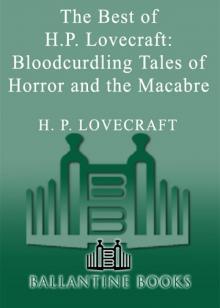 The Best of H.P. Lovecraft
The Best of H.P. Lovecraft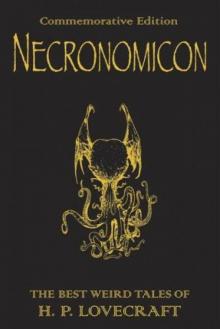 The Definitive H.P. Lovecraft: 67 Tales Of Horror In One Volume
The Definitive H.P. Lovecraft: 67 Tales Of Horror In One Volume The Complete Works of H.P. Lovecraft
The Complete Works of H.P. Lovecraft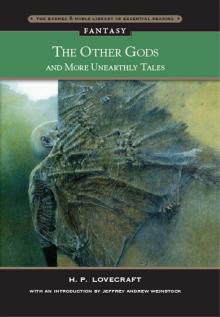 Other Gods and More Unearthly Tales
Other Gods and More Unearthly Tales Lovecraft's Fiction Volume I, 1905-1925
Lovecraft's Fiction Volume I, 1905-1925 The Shadow Out of Time
The Shadow Out of Time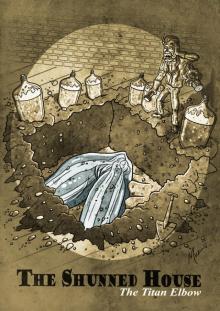 The Shunned House
The Shunned House Lovecraft's Fiction Volume II, 1926-1928
Lovecraft's Fiction Volume II, 1926-1928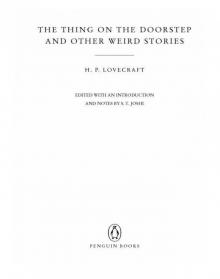 The Thing on the Doorstep and Other Weird Stories
The Thing on the Doorstep and Other Weird Stories Dream Cycle of H. P. Lovecraft: Dreams of Terror and Death
Dream Cycle of H. P. Lovecraft: Dreams of Terror and Death Great Tales of Horror
Great Tales of Horror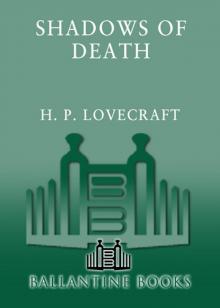 Shadows of Death
Shadows of Death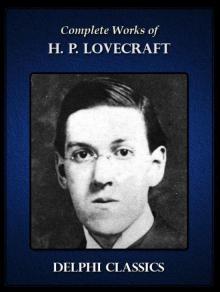 Delphi Complete Works of H. P. Lovecraft (Illustrated)
Delphi Complete Works of H. P. Lovecraft (Illustrated)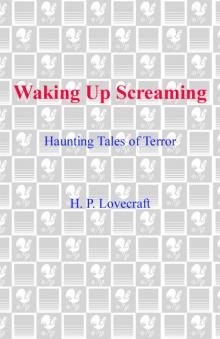 Waking Up Screaming: Haunting Tales of Terror
Waking Up Screaming: Haunting Tales of Terror H.P. Lovecraft Goes to the Movies
H.P. Lovecraft Goes to the Movies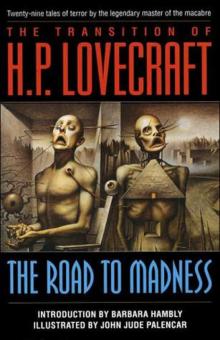 The Road to Madness
The Road to Madness The Complete H.P. Lovecraft Reader (68 Stories)
The Complete H.P. Lovecraft Reader (68 Stories) The Horror in the Museum
The Horror in the Museum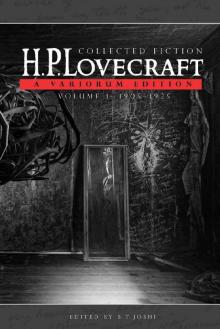 Collected Fiction Volume 1 (1905-1925): A Variorum Edition
Collected Fiction Volume 1 (1905-1925): A Variorum Edition Lovecrafts_Fiction, vol.I_1905-1925
Lovecrafts_Fiction, vol.I_1905-1925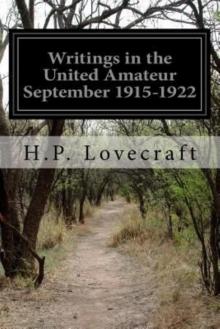 Writings in the United Amateur, 1915-1922
Writings in the United Amateur, 1915-1922 H.P. Lovecraft: The Complete Works
H.P. Lovecraft: The Complete Works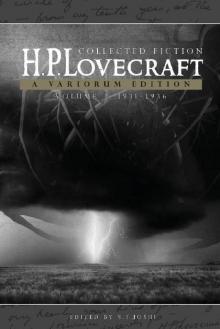 Collected Fiction Volume 3 (1931-1936): A Variorum Edition
Collected Fiction Volume 3 (1931-1936): A Variorum Edition H.P. Lovecraft: The Complete Fiction
H.P. Lovecraft: The Complete Fiction Collected Fiction Volume 2 (1926-1930): A Variorum Edition
Collected Fiction Volume 2 (1926-1930): A Variorum Edition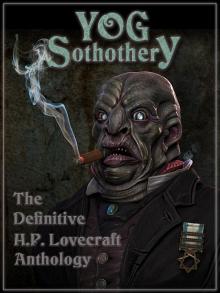 Yog Sothothery - The Definitive H.P. Lovecraft Anthology
Yog Sothothery - The Definitive H.P. Lovecraft Anthology The Complete H.P. Lovecraft Collection (Xist Classics)
The Complete H.P. Lovecraft Collection (Xist Classics)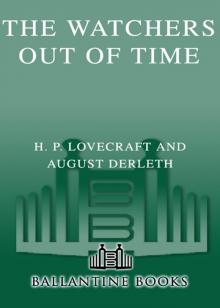 The Watchers Out of Time
The Watchers Out of Time Eldritch Tales
Eldritch Tales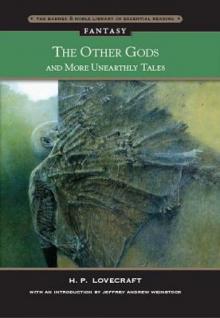 The Other Gods And More Unearthly Tales
The Other Gods And More Unearthly Tales The New Annotated H. P. Lovecraft
The New Annotated H. P. Lovecraft At the mountains of madness
At the mountains of madness Bloodcurdling Tales of Horror and the Macabre
Bloodcurdling Tales of Horror and the Macabre Fossil Lake II: The Refossiling
Fossil Lake II: The Refossiling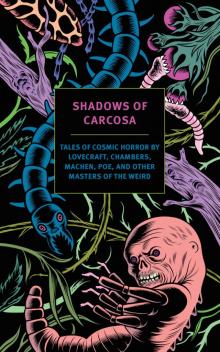 Shadows of Carcosa: Tales of Cosmic Horror by Lovecraft, Chambers, Machen, Poe, and Other Masters of the Weird
Shadows of Carcosa: Tales of Cosmic Horror by Lovecraft, Chambers, Machen, Poe, and Other Masters of the Weird H. P. Lovecraft
H. P. Lovecraft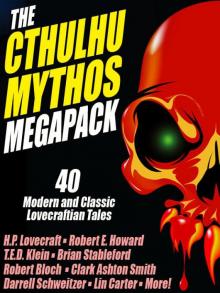 The Cthulhu Mythos Megapack
The Cthulhu Mythos Megapack The Complete H. P. Lovecraft Reader (2nd Edition)
The Complete H. P. Lovecraft Reader (2nd Edition) The Complete Fiction
The Complete Fiction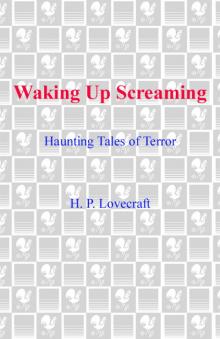 Waking Up Screaming
Waking Up Screaming Transition of H. P. Lovecraft
Transition of H. P. Lovecraft![[1935] The Shadow Out of Time Read online](http://i1.bookreadfree.com/i2/04/12/1935_the_shadow_out_of_time_preview.jpg) [1935] The Shadow Out of Time
[1935] The Shadow Out of Time The Horror Megapack
The Horror Megapack